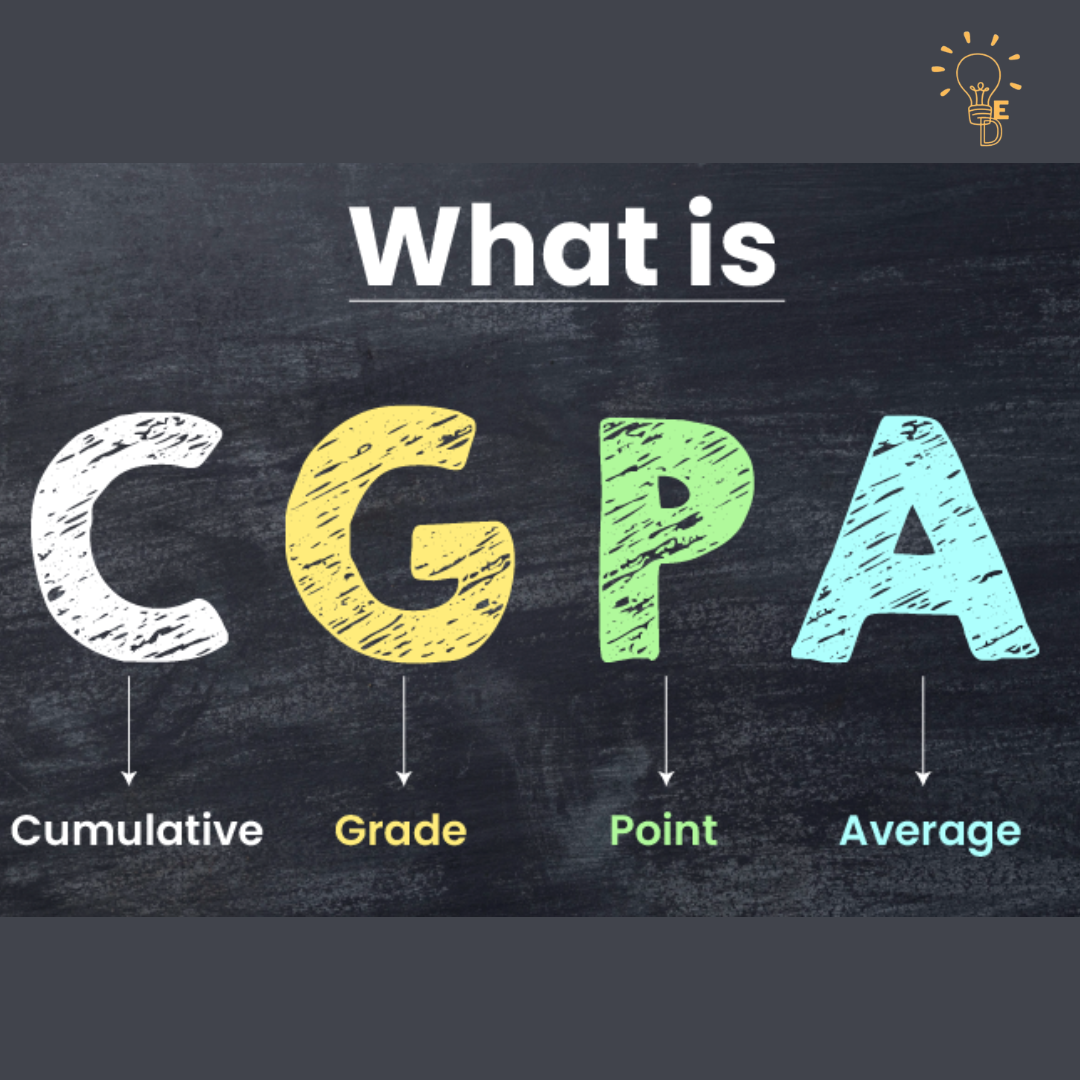CGPA full form is Cumulative Grade Point Average, It is one of the important indicator of academic performance. to know about CGPA is very important, it’s uses, how CGPA calculated and how it is different from GPA and SGPA? Read this blog till the very end you will get to know everything related to CGPA.
What is an CGPA?
CGPA stands for Cumulative Grade Point Average. CGPA is a numerical representation of student’s academic performance during a period of time, for say a semester or a year. It is used in Indian Education system as well as Globally to make grading system as standardized. CGPA influence various aspects of student’s career from further education, scholarships to jobs CGPA have an important role to show student’s academic excellence.

Why is CGPA Important- Benefits of CGPA
CGPA plays an important role in student’s career as CGPA will help students in scholarships, further educational opportunities, jobs and much more. CGPA is one of the important indicator to show student’s academic excellence. Here are some other importance factors-
- Apply for college admissions
- Sit for competitive exams
- Secure scholarships
- Build a strong academic portfolio
- Apply to foreign universities
Benefits of CGPA
Simplified Evaluation: Converts multiple subject marks into one comprehensive score.
Consistency Across Systems: Allows comparability between students and schools.
Encourages Balanced Learning: Focuses on overall development, not just marks.
Limitations of CGPA
Despite it’s show much importance, CGPA have some limitations and challenges-
Lack of Detail:
CGPA may not offer a detailed breakdown of a student’s performance in specific subjects or areas of study. It just show the cumulative or total average which don’t provide a detailed overview for strong and weak subjects to students.
Contextual Differences:
The grading scale used for CGPA calculation may not consider contextual differences in education systems, leading to disparities in assessment.
Omitting Important Details:
Relying solely on CGPA may overlook important aspects of academic achievement, such as extracurricular activities or practical skills.
CGPA in Indian Education System (2025 Update)
According to CBSE guidelines, the CGPA system was introduced to reduce exam stress and focus on learning rather than rote memorization.
CBSE Grading Scale- Latest
| Grade | Grade Point |
|---|---|
| A1 | 10 |
| A2 | 9 |
| B1 | 8 |
| B2 | 7 |
| C1 | 6 |
| C2 | 5 |
| D | 4 |
| E1/E2 | Fail |
Formula to calculate CGPA:
CGPA = Sum of grade points in all subjects / Number of subjects
Example: If your subject-wise GPAs are 9, 8, 10, 9, and 8
Then, CGPA = (9+8+10+9+8) / 5 = 8.8
How to Convert CGPA to Percentage: Convert Your Grades Easily
Understanding the concept of converting CGPA to Percentage is important as some institutions and Employers consider percentange, so here is a simple calculation of convert CGPA to percentage-
According to the CBSE (Central Board of Secondary Education) guidelines and widely accepted academic standards in India, the formula to convert CGPA to percentage is:
Percentage (%) = CGPA × 9.5
Example: How to Convert CGPA to Percentage
Let’s say your CGPA is 8.2.
Using the formula:
Percentage = 8.2 × 9.5 = 77.9%
So your score is 77.9%.
| Grade | Grade Point (GP) | CGPA Range | Percentage (Approx) | Performance |
|---|---|---|---|---|
| A1 | 10 | 9.1 – 10 | 91% – 100% | Outstanding |
| A2 | 9 | 8.1 – 9.0 | 81% – 90% | Excellent |
| B1 | 8 | 7.1 – 8.0 | 71% – 80% | Very Good |
| B2 | 7 | 6.1 – 7.0 | 61% – 70% | Good |
| C1 | 6 | 5.1 – 6.0 | 51% – 60% | Satisfactory |
| C2 | 5 | 4.1 – 5.0 | 41% – 50% | Average |
| D | 4 | 3.5 – 4.0 | 33% – 40% | Below Average |
| E1 / E2 | – | < 3.5 | < 33% | Needs Improvement |
CGPA in Worldwide Universities
In international universities (like the US, Canada, or Europe), GPA and CGPA are key metrics used in:
College admissions
Internship eligibility
Academic probation or honors programs
Many universities use a 4.0 GPA scale, so Indian students often need to convert their CGPA accordingly when applying abroad.
CGPA and GPA? are they same?
One of the most common questions students have is: “Are CGPA and GPA the same thing?” While they may seem similar, there are key differences in meaning, usage, and calculation, especially when you’re applying for international universities or jobs.
Let’s break it down:
| Criteria | CGPA (Cumulative Grade Point Average) | GPA (Grade Point Average) |
|---|---|---|
| Full Form | Cumulative Grade Point Average | Grade Point Average |
| Usage | Common in India, Pakistan, and other Asian countries | Common in the United States, Canada, Australia, etc. |
| Duration Covered | Reflects performance across an academic year or entire course | Measures performance for one term, semester, or year |
| Scale | Usually calculated on a 10-point scale | Calculated on a 4-point scale (some use 5 or 12) |
| Purpose | Standardized academic evaluation in Indian institutions | Used for admissions, honors, and scholarships abroad |
| Decimal Accuracy | Typically shows up to 1 decimal point (e.g., 8.6) | Often displayed up to 2 decimal points (e.g., 3.75) |
| Percentage Conversion | Follows a fixed formula (e.g., CGPA × 9.5) | Depends on letter grades like A+, B-, C, etc. |
Detailed Explanation:
What is CGPA?
CGPA (Cumulative Grade Point Average) is widely used in India, especially in school boards like CBSE and many universities. It reflects the average grade points earned across all subjects over a year or full program, not just one semester.
For example, a CGPA of 9.0 generally indicates an overall score of 85.5% (when multiplied by 9.5).
What is GPA?
GPA (Grade Point Average) is a grading metric used internationally. It calculates the average of your grades in a specific semester. In most systems, each letter grade (A, B, C, etc.) is assigned a numerical value:
| Grade | Points (4.0 scale) |
|---|---|
| A | 4.0 |
| B | 3.0 |
| C | 2.0 |
| D | 1.0 |
| F | 0.0 |
So, if a student takes 5 courses in one semester and scores 3 A’s and 2 B’s, their GPA will be:
GPA = (4 + 4 + 4 + 3 + 3) / 5 = 3.6

CGPA to GPA Conversion (For International Students)
There is no direct universal formula to convert CGPA to GPA, because:
CGPA uses a 10-point scale, while GPA uses 4-point scale
GPA depends on credit hours and course weightage
Universities may have different grading standards
Still, as a general approximate conversion:
| CGPA (10-point) | GPA (4-point) |
|---|---|
| 9.0 – 10 | 3.7 – 4.0 |
| 8.0 – 8.9 | 3.3 – 3.6 |
| 7.0 – 7.9 | 2.7 – 3.2 |
| 6.0 – 6.9 | 2.0 – 2.6 |
| Below 6.0 | Below 2.0 |
FAQs on CGPA
1. What Is CGPA Multiplying Factor?
The CGPA multiplying factor is used to convert individual course grades into a cumulative grade point average (CGPA). It varies depending on the grading system used by the institution.
2. How Important Is CGPA for Admissions?
CGPA is often an important factor for admissions to further education programs or for certain job opportunities, as it serves as a measure of academic performance and potential.
3. How Does CGPA Impact Career Prospects?
CGPA can impact career prospects by influencing opportunities for further education, scholarships, internships, and job offers. Many employers and educational institutions consider CGPA as an indicator of a candidate’s academic capability and dedication.
4. Is It Possible to Improve CGPA If It Is Low?
Yes, it’s possible to improve a low CGPA through various means such as seeking help from tutors, improving study habits, retaking courses if permitted, focusing on high-value courses, and maintaining consistency in academic performance.
5. What Is a Good CGPA Range to Aim for?
A good CGPA range to aim for can vary depending on your academic goals, the competitiveness of the field you’re interested in, and the standards of the institutions you’re applying to. Generally, aiming for a CGPA above 8.0 (on a 10.0 scale) is considered favorable for many opportunities.
6. How Often Is CGPA Updated in Academic Records?
CGPA is typically updated at the end of each semester or academic term when grades for all courses are finalized and recorded.
7. Can I Calculate My Own CGPA Using My Grades?
Yes, you can calculate your own CGPA using your grades by multiplying the grade points for each course by the course credits, summing them up, and dividing by the total number of credits. Each institution may have its own specific formula for CGPA calculation.
8. Are There Any Specific Strategies to Maintain a High CGPA Throughout the Academic Year?
Strategies to maintain a high CGPA include:
- staying organized,
- attending classes regularly,
- actively participating in discussions,
- seeking help when needed,
- managing time effectively,
- reviewing course materials regularly,
- setting realistic goals,
- and maintaining a healthy balance between academics and personal life.
Additionally, seeking feedback from professors and adjusting study strategies accordingly can also be beneficial.
9. How much CGPA is considered good?
A CGPA above 8.0 (equivalent to ~76%) is generally considered excellent.
10. What is the CGPA full form in Hindi?
CGPA का फुल फॉर्म है: Cumulative Grade Point Average




Pingback: Bonafide Certificate Format, Uses and Application